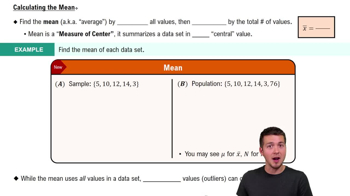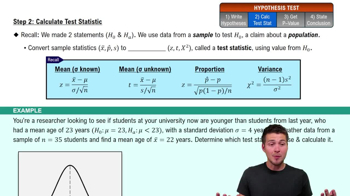Test Values p_cap1, p_cap2. Find the values of and the pooled proportion p_bar obtained when testing the claim given in Exercise 1.
Table of contents
- 1. Intro to Stats and Collecting Data1h 14m
- 2. Describing Data with Tables and Graphs1h 55m
- 3. Describing Data Numerically2h 5m
- 4. Probability2h 16m
- 5. Binomial Distribution & Discrete Random Variables3h 6m
- 6. Normal Distribution and Continuous Random Variables2h 11m
- 7. Sampling Distributions & Confidence Intervals: Mean3h 23m
- Sampling Distribution of the Sample Mean and Central Limit Theorem19m
- Distribution of Sample Mean - Excel23m
- Introduction to Confidence Intervals15m
- Confidence Intervals for Population Mean1h 18m
- Determining the Minimum Sample Size Required12m
- Finding Probabilities and T Critical Values - Excel28m
- Confidence Intervals for Population Means - Excel25m
- 8. Sampling Distributions & Confidence Intervals: Proportion1h 12m
- 9. Hypothesis Testing for One Sample3h 29m
- 10. Hypothesis Testing for Two Samples4h 50m
- Two Proportions1h 13m
- Two Proportions Hypothesis Test - Excel28m
- Two Means - Unknown, Unequal Variance1h 3m
- Two Means - Unknown Variances Hypothesis Test - Excel12m
- Two Means - Unknown, Equal Variance15m
- Two Means - Unknown, Equal Variances Hypothesis Test - Excel9m
- Two Means - Known Variance12m
- Two Means - Sigma Known Hypothesis Test - Excel21m
- Two Means - Matched Pairs (Dependent Samples)42m
- Matched Pairs Hypothesis Test - Excel12m
- 11. Correlation1h 6m
- 12. Regression1h 50m
- 13. Chi-Square Tests & Goodness of Fit1h 57m
- 14. ANOVA1h 57m
9. Hypothesis Testing for One Sample
Steps in Hypothesis Testing
Problem 9.4.3
Textbook Question
Test for Normality For the hypothesis test described in Exercise 2, the sample sizes are n1 = 2208 and n2 = 1986 When using the F test with these data, is it correct to reason that there is no need to check for normality because both samples have sizes that are greater than 30?
 Verified step by step guidance
Verified step by step guidance1
Understand the context: The problem involves testing for normality in the context of an F-test. The F-test is sensitive to deviations from normality, so it is important to assess whether the assumption of normality holds for the data.
Recall the rule of thumb: While it is true that for many statistical tests (e.g., t-tests), large sample sizes (n > 30) can mitigate the effects of non-normality due to the Central Limit Theorem, this does not apply to the F-test. The F-test is particularly sensitive to non-normality, even with large sample sizes.
Explain the importance of checking normality: For the F-test, the assumption of normality is critical because the test statistic is based on the ratio of variances, and deviations from normality can lead to incorrect conclusions. Therefore, it is not sufficient to rely solely on the large sample sizes.
Describe methods to check for normality: To assess normality, you can use graphical methods (e.g., Q-Q plots, histograms) or statistical tests (e.g., Shapiro-Wilk test, Anderson-Darling test). These methods can help determine whether the data approximately follow a normal distribution.
Conclude the reasoning: Based on the sensitivity of the F-test to non-normality, it is incorrect to assume that there is no need to check for normality simply because the sample sizes are large. Normality should still be assessed to ensure the validity of the F-test results.
 Verified video answer for a similar problem:
Verified video answer for a similar problem:This video solution was recommended by our tutors as helpful for the problem above
Video duration:
1mPlay a video:
Was this helpful?
Key Concepts
Here are the essential concepts you must grasp in order to answer the question correctly.
Central Limit Theorem
The Central Limit Theorem states that, for a sufficiently large sample size, the sampling distribution of the sample mean will be approximately normally distributed, regardless of the population's distribution. This theorem is crucial in statistics as it justifies the use of normal distribution in hypothesis testing when sample sizes exceed 30, allowing for more robust conclusions.
Recommended video:
Guided course

Calculating the Mean
F-Test
The F-test is a statistical test used to compare the variances of two populations. It is commonly applied in the context of ANOVA (Analysis of Variance) and assumes that the data from both groups are normally distributed. Understanding the F-test is essential for determining if the observed variances are significantly different, which can influence the validity of the results.
Recommended video:
Guided course

Step 2: Calculate Test Statistic
Normality Assumption
The normality assumption refers to the requirement that the data being analyzed should follow a normal distribution for many statistical tests to be valid. While larger sample sizes can mitigate the impact of non-normality due to the Central Limit Theorem, it is still important to assess the data's distribution, especially when sample sizes are not excessively large or when the data is heavily skewed.
Recommended video:
Guided course

Finding Standard Normal Probabilities using z-Table

 6:21m
6:21mWatch next
Master Step 1: Write Hypotheses with a bite sized video explanation from Patrick
Start learningRelated Videos
Related Practice
Textbook Question
